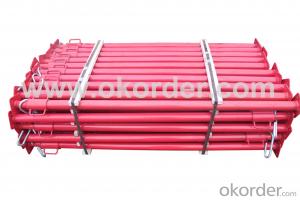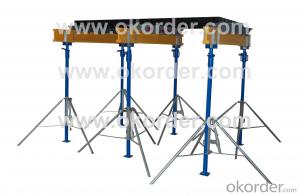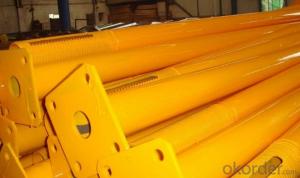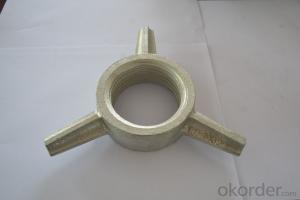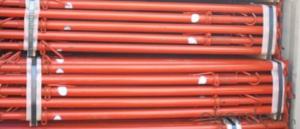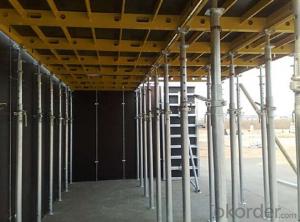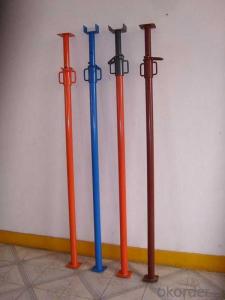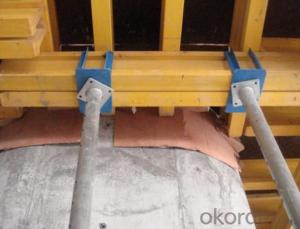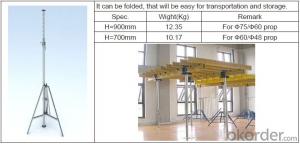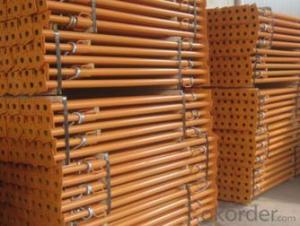steel shoring prop for formwork
- Loading Port:
- Tianjin
- Payment Terms:
- TT OR LC
- Min Order Qty:
- -
- Supply Capability:
- 100000 pc/month
OKorder Service Pledge
OKorder Financial Service
You Might Also Like
shoring prop
Specifications
1. light weight, high strength
2. sustainable and enviroment friendly
3. reusable
4. easy operate
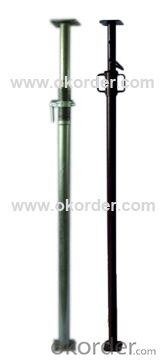
Product Description
Shoring prop supporting system is used to support formwork system. The system composed by shoring prop, tripod, fork and H20 beam, and then put the formwork panels on the H20 beam to make slab. The maxium loading on one single prop (2-4m) is 1.1 ton when the height adjust to 4m, the high capacity of loading gurantee the safety of the whole formwork system.

Concept
We are the professional supplier of formwork, scaffolding, couplers, prop, etc. As the leading supplier of modular formwork in North East China, we endeavour to help you build faster and conveniently, and most important, guarantee the safety for workers. We also endeavour to protect environment because we only have one earth.
Thanks to our credibility and high quality products, the company has built long term cooperation relationship with many world class enterprises such as Saudi Arabia ATCO group,
Russia Sakhalin Energy Investment Company, Italy Geoplast Company, etc.
Product Characteristics
| product name | Shoring prop supporting system |
| origin | China |
| color | As required |
| material | Q235 |
| weight | 15kg |
| max load | 1.1 ton |
| brand | BOFU |
| adjustable height | 2-4m |
| surface treatment | powder coated |
Product Introduction
Handier
The weight of prop is 15kg, one worker can hold it easily.
easy set up
Use tripod, prop, fork and H20 beam, the supporting system can be set up easily.
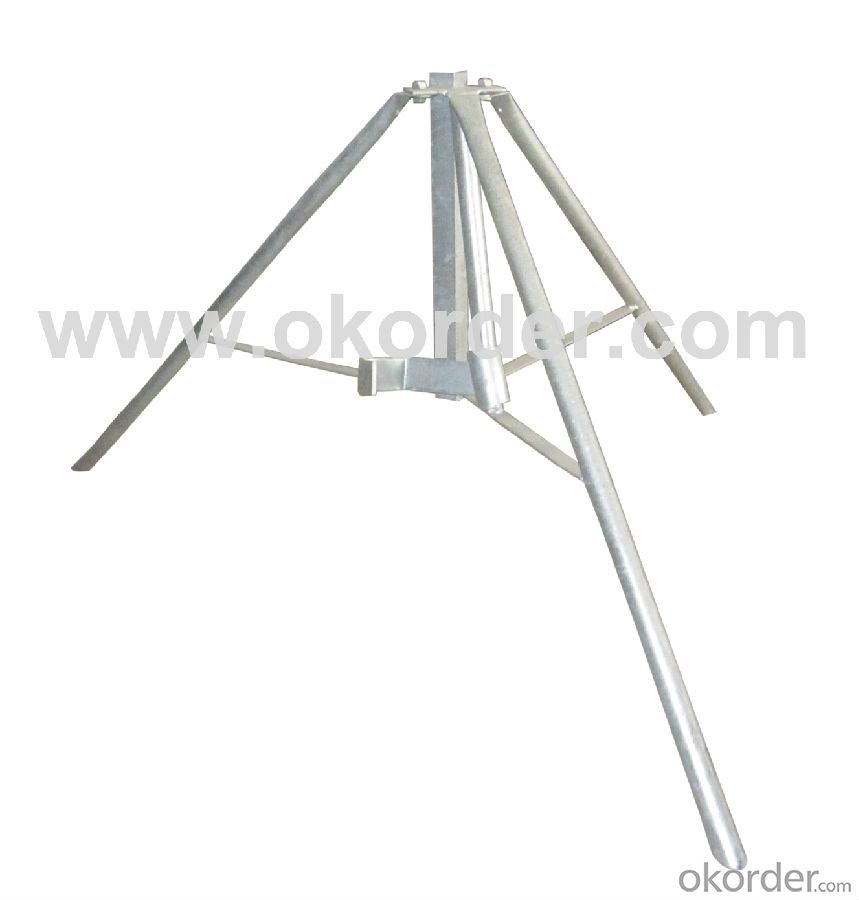

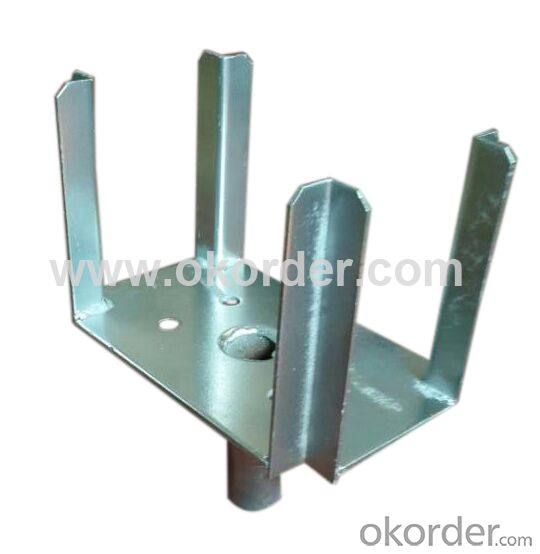
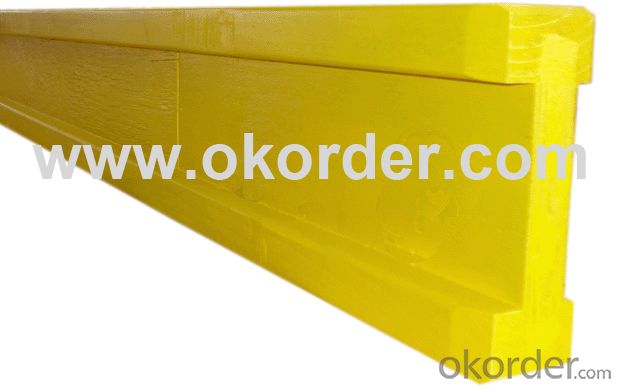
Strength
The material of prop is Q235, the maximum load of single prop is 1.1 ton when the height adjust to 4m, just add or reduce the number of props to fit 10-40cm thickness slab.
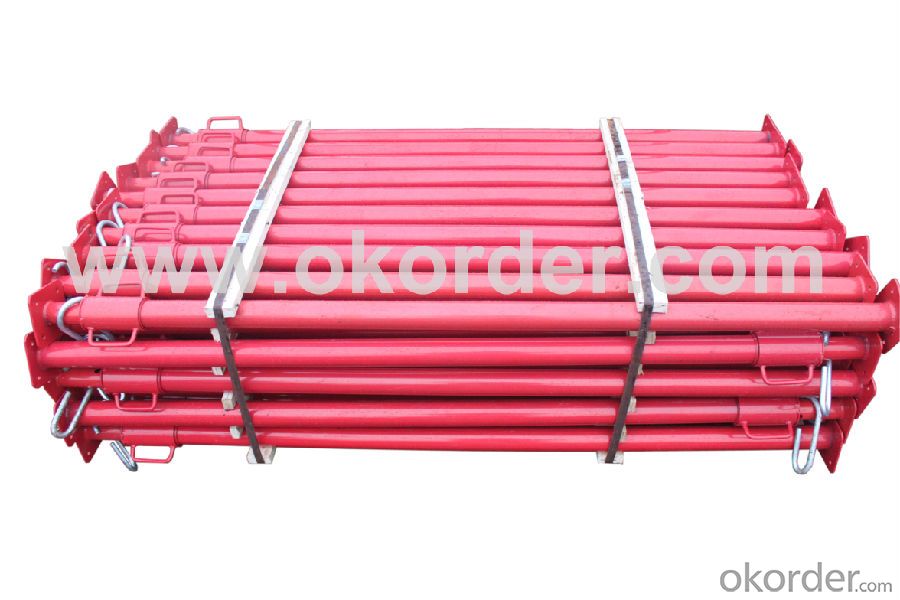
Package
The system can packed seperately by pallet, easy to transport.
shoring prop
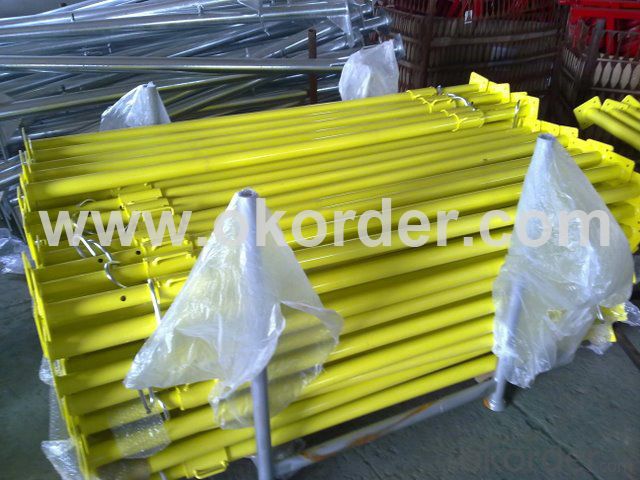
H20 beam
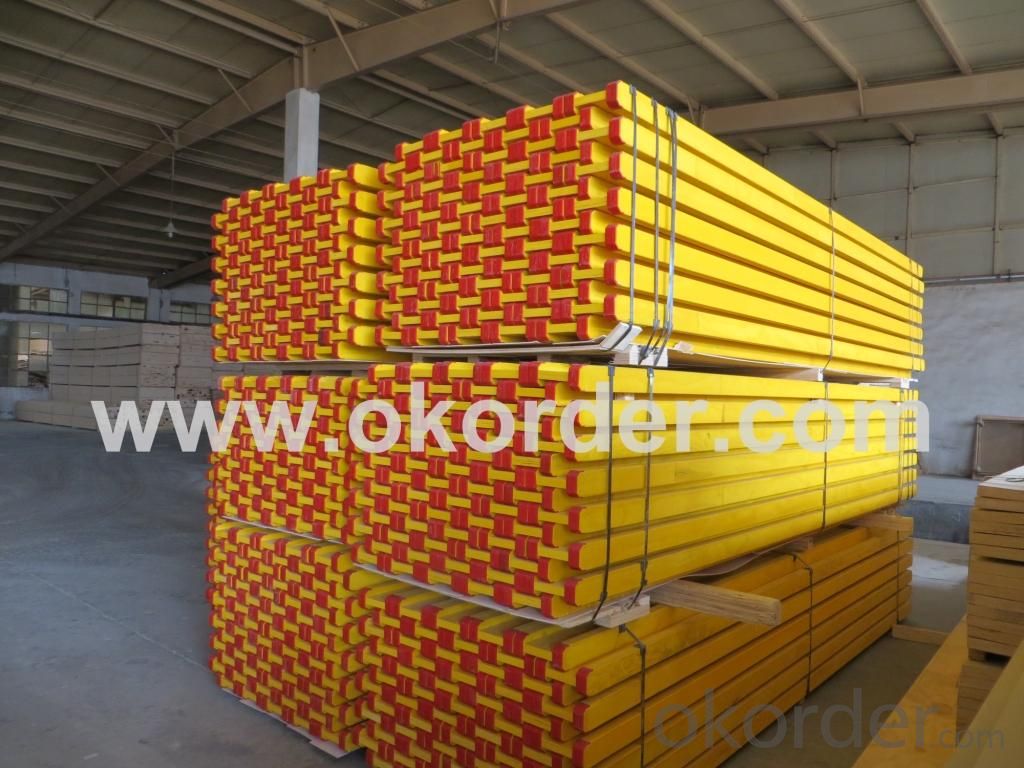
project Sample

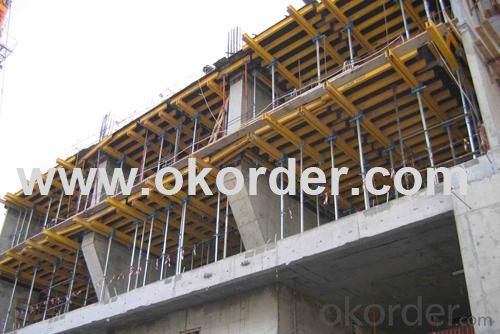
Please send your enquiry to us, we will be your service at any time.
- Q:Are steel props adjustable in both inclination and declination?
- No, steel props are not adjustable in both inclination and declination. Steel props, also known as steel shore or steel acrow prop, are vertical supports commonly used in construction to provide temporary support to structures during construction or renovation. They are designed to be adjustable in height, allowing for easy adaptation to different heights or levels. However, they are not designed to be adjustable in inclination or declination. Their main purpose is to provide vertical support, and any adjustment in inclination or declination would compromise their stability and structural integrity.
- Q:Can steel props be used for temporary support during beam installation?
- Yes, steel props can be used for temporary support during beam installation. Steel props are adjustable supports that are commonly used in construction to provide temporary support to beams, slabs, walls, and other structural elements. They are designed to be strong and stable, capable of supporting heavy loads. Steel props can be easily adjusted to the desired height and are suitable for various construction applications, including beam installation. Their versatility and load-bearing capacity make them an ideal choice for temporary support during beam installation.
- Q:How do steel props compare to telescopic props in terms of performance?
- Steel props and telescopic props are both commonly used in construction projects for providing temporary support to structures. In terms of performance, steel props are known for their exceptional load-bearing capacity, stability, and durability. They are typically made of high-quality steel, making them suitable for heavy-duty applications. On the other hand, telescopic props offer the advantage of adjustability, allowing for easy height modification and precise positioning. However, they may have a lower load-bearing capacity compared to steel props. Overall, the choice between steel props and telescopic props depends on the specific requirements of the project, with steel props being more suitable for heavy loads and telescopic props being ideal for flexible and adjustable support.
- Q:Can steel props be used in road construction?
- Yes, steel props can be used in road construction. Steel props are commonly used in construction projects to provide temporary support or reinforcement to structures. In road construction, they can be used to support formwork during the pouring of concrete, provide additional stability to excavation sites, or assist in the installation of temporary barriers or signage. Their strength and durability make them suitable for various applications in road construction projects.
- Q:Can steel props be used for supporting heavy machinery?
- Supporting heavy machinery can be done using steel props. These props, also referred to as adjustable steel props or steel support props, are robust and sturdy support structures commonly utilized in construction and engineering projects. They are designed to offer temporary support and stability to heavy loads or structures, which includes heavy machinery. Steel props are composed of a telescopic steel tube with an adjustable mechanism that allows for easy height adjustment and secure locking. This feature of adjustability makes them suitable for supporting heavy machinery that varies in height and weight. Furthermore, steel props are acknowledged for their high load-bearing capacity, enabling them to withstand the weight and pressure exerted by heavy machinery. To ensure optimal stability, correct positioning, secure locking, and even distribution of the props are crucial when using steel props to support heavy machinery. Proper placement and distribution of the props help prevent any imbalance or instability that could potentially result in accidents or damage to the machinery. Nevertheless, it is crucial to consult the manufacturer's guidelines, engineering professionals, or structural engineers before utilizing steel props to support heavy machinery. This consultation will ensure that the props are compatible with the specific weight and requirements of the machinery. Additionally, seeking professional assistance can aid in determining the appropriate number of steel props required, their positioning, and any additional safety measures necessary for proper machinery support. In conclusion, steel props are indeed suitable for supporting heavy machinery. Their strength, adjustability, and load-bearing capacity make them appropriate for providing temporary support and stability in various construction and engineering applications. However, it is vital to seek professional advice and adhere to proper guidelines to ensure the safe and effective use of steel props when supporting heavy machinery.
- Q:How do steel props compare to trench jacks in terms of performance?
- Steel props and trench jacks serve similar purposes in providing temporary support to trenches or other structures. However, steel props generally offer better performance compared to trench jacks due to their adjustable height and load-bearing capacity. Steel props can easily be adjusted to different heights, allowing for better flexibility and adaptability in various construction scenarios. Additionally, steel props are typically designed to support heavier loads, making them more suitable for demanding construction projects. Overall, steel props offer improved performance and versatility compared to trench jacks.
- Q:How do you ensure proper communication between different work teams using steel props?
- To ensure proper communication between different work teams using steel props, the following strategies can be employed: 1. Clear communication channels should be established, allowing teams to effectively communicate. This may involve utilizing tools such as email, project management software, or instant messaging platforms. 2. Regular team meetings should be encouraged to discuss progress, challenges, and relevant updates. Such meetings facilitate communication and collaboration among different teams, ensuring everyone is informed and aligned. 3. A dedicated communication coordinator can be assigned to facilitate effective communication between teams. This individual acts as a liaison, ensuring timely and accurate flow of communication. 4. A culture of open communication should be fostered, where team members are encouraged to voice their thoughts, ask questions, and share ideas. Creating an environment where everyone feels comfortable expressing themselves enhances communication between teams. 5. Visual aids and documentation can be utilized to enhance understanding and communication. Charts, diagrams, and project timelines can assist in conveying information, while documenting important decisions and progress updates in a shared location ensures everyone is informed. 6. Regular team-building activities can be organized to improve relationships and communication between work teams. These activities may include workshops, retreats, or team-building exercises that encourage collaboration and interpersonal communication. 7. Training sessions and workshops on effective communication techniques and tools should be provided to team members. Offering resources and support empowers individuals to communicate more effectively within and across teams. 8. A collaborative work environment should be fostered, providing opportunities for teams to work together on projects or initiatives. This promotes better understanding and communication between different work teams. 9. Feedback should be actively encouraged, and continuous improvement should be sought. Regularly seeking feedback from team members on communication processes and implementing improvements based on suggestions ensures ongoing improvement in communication practices. By implementing these strategies, proper communication between different work teams using steel props can be ensured, leading to improved coordination, productivity, and overall project success.
- Q:What are the common applications of steel props in construction?
- Steel props, also called acrow props or adjustable steel props, find widespread use in construction for various purposes. Supporting structures during construction or renovation is one of their primary functions. They provide temporary support to beams, walls, ceilings, or other structural elements that require additional support while work is underway. Steel props possess adjustability, making them suitable for different heights and load-bearing capacities. This adjustability facilitates easy and secure adjustment and fastening of the props to offer the required support. Steel props also serve as common supports for formwork during concrete pouring. Formwork refers to the temporary structure that holds the concrete in place until it gains self-supporting strength after curing. Steel props guarantee the stability and security of the formwork during the pouring process, preventing any distortion or collapse. Moreover, steel props find usage in shoring applications. Shoring refers to the provision of temporary support to an existing structure that may have suffered damage or weakening due to various factors such as earthquakes, accidents, or renovations. Steel props stabilize and reinforce the damaged structure until permanent repairs can be executed. Another area where steel props are utilized is in scaffolding systems. Scaffolding is a temporary structure erected to offer access and support to workers during construction, maintenance, or repair operations. Steel props frequently serve as vertical supports in scaffolding systems, ensuring the stability and safety of the structure. In summary, steel props are versatile and extensively employed in construction due to their adjustability, strength, and reliability. They play a crucial role in delivering temporary support and stability to structures during diverse construction processes, ensuring the safety of workers and the integrity of the project.
- Q:Can steel props be used in residential foundation repair?
- Yes, steel props can be used in residential foundation repair. Steel props, also known as adjustable steel supports or jacks, are commonly used in foundation repair projects to provide temporary support and stabilization to damaged or weakened foundations. These props are adjustable in height and can be placed strategically to distribute the load and provide structural support during the repair process.
- Q:What are the main advantages of using non-adjustable steel props?
- There are several main advantages of using non-adjustable steel props in construction projects. Firstly, non-adjustable steel props offer a high level of stability and load-bearing capacity. These props are designed to support heavy loads and provide a secure and reliable structure. This is particularly beneficial in situations where there is a need for extra strength and stability, such as in the construction of tall buildings or large-scale infrastructure projects. Secondly, non-adjustable steel props are easy to install and operate. They come in pre-determined lengths, which eliminates the need for time-consuming adjustments. This not only saves time and effort during the installation process but also reduces the risk of human error. Additionally, the simplicity of non-adjustable steel props makes them ideal for use in a wide range of construction projects, from small-scale renovations to large-scale developments. Another advantage is the durability and longevity of non-adjustable steel props. These props are typically made from high-quality steel, which is known for its strength and resistance to damage. This means that they can withstand harsh weather conditions, heavy loads, and frequent use without deteriorating or losing their structural integrity. As a result, non-adjustable steel props provide long-term reliability and can be reused in multiple projects, making them a cost-effective solution. Furthermore, non-adjustable steel props offer versatility in application. They can be used in various construction scenarios, including formwork support, temporary scaffolding, and shoring systems. Their ability to adapt to different project requirements makes them highly versatile and practical. This versatility also extends to their compatibility with other construction materials, allowing for seamless integration into existing structures. Lastly, non-adjustable steel props are a safer option compared to alternative support systems. Their robust design ensures a stable and secure working environment for construction workers. Additionally, their load-bearing capacity reduces the risk of accidents or collapses during construction activities. This promotes a safer working environment and minimizes potential injuries or fatalities. In conclusion, the main advantages of using non-adjustable steel props include their high stability and load-bearing capacity, ease of installation and operation, durability and longevity, versatility in application, and enhanced safety features. These factors make non-adjustable steel props a popular choice in construction projects, providing a reliable and efficient support system.
1. Manufacturer Overview |
|
|---|---|
| Location | |
| Year Established | |
| Annual Output Value | |
| Main Markets | |
| Company Certifications | |
2. Manufacturer Certificates |
|
|---|---|
| a) Certification Name | |
| Range | |
| Reference | |
| Validity Period | |
3. Manufacturer Capability |
|
|---|---|
| a)Trade Capacity | |
| Nearest Port | |
| Export Percentage | |
| No.of Employees in Trade Department | |
| Language Spoken: | |
| b)Factory Information | |
| Factory Size: | |
| No. of Production Lines | |
| Contract Manufacturing | |
| Product Price Range | |
Send your message to us
steel shoring prop for formwork
- Loading Port:
- Tianjin
- Payment Terms:
- TT OR LC
- Min Order Qty:
- -
- Supply Capability:
- 100000 pc/month
OKorder Service Pledge
OKorder Financial Service
Similar products
New products
Hot products
Hot Searches
Related keywords

